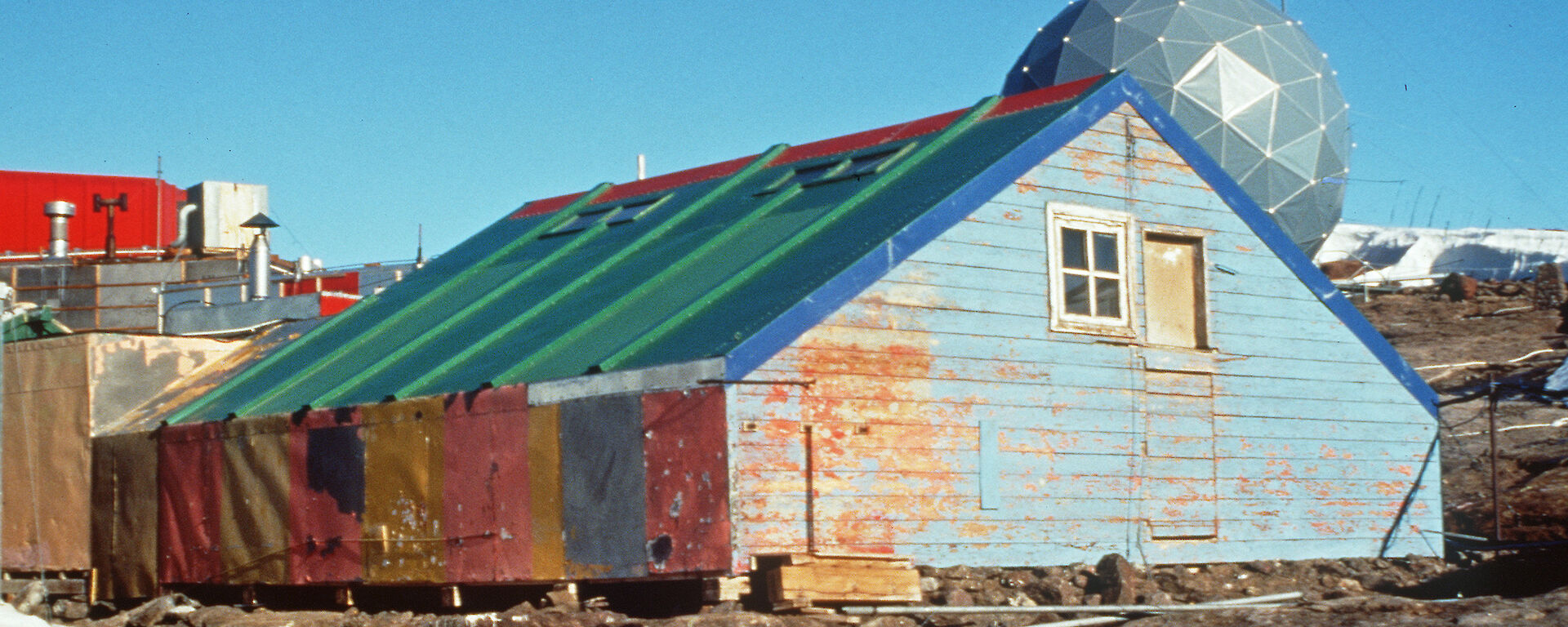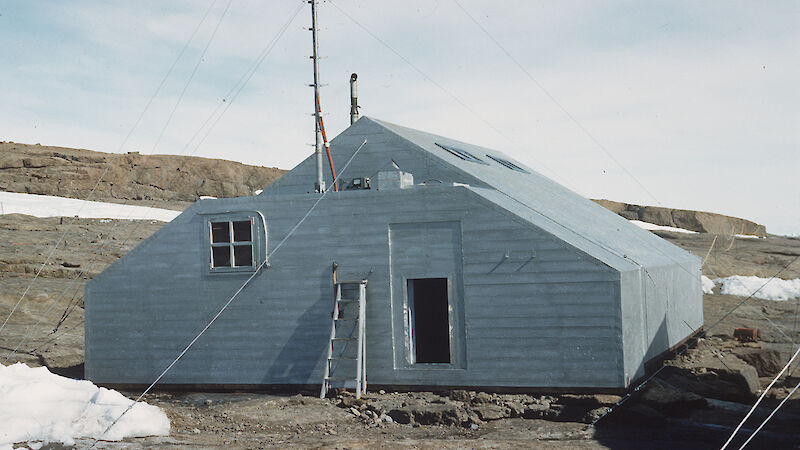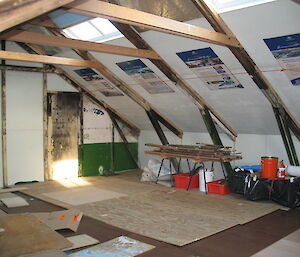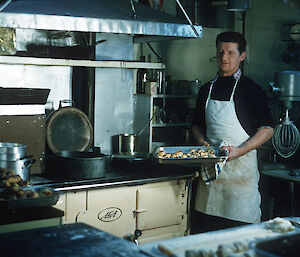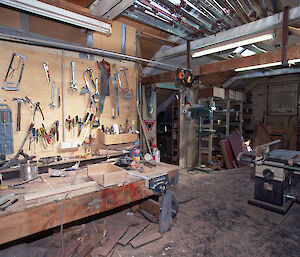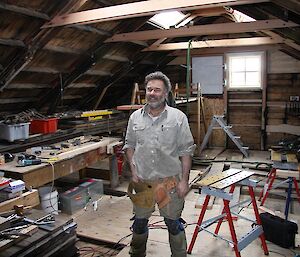A project to restore and preserve one of the earliest relics of ANARE (Australian National Antarctic Research Expeditions) history is underway at Mawson station. Biscoe Hut was one of the first buildings erected at Mawson when the station was established in 1954. Its eight metre square space contained the original living and sleeping quarters, mess and kitchen.
The hut was one of three prefabricated by the Norwegian Polar Institute for the 1949–52 Norwegian-Swedish-British Antarctic Expedition to Queen Maud Land, but it was left behind in Cape Town (South Africa) due to lack of cargo space. ANARE Director Phil Law had seen its sister huts in use at Maudheim station in Antarctica on a visit in 1949, and persuaded the Australian Government to purchase the kit in 1952 for use on the first ANARE expedition to Antarctica.
Biscoe was designed for Antarctic conditions and represented the most modern design and technology available in its day. Its pre-cut, modular pieces were easily transported, it was able to be erected on snow or ice due to the design of the sub-floor framing, and it could withstand burial by years of blizzard.
When the hut arrived at Mawson on February 13, 1954, the summer season was waning and temperatures were rapidly dropping. As the main accommodation for 10 wintering expeditioners, Biscoe’s erection was a priority. But it took almost a month to first construct level foundations on Mawson’s rough, rocky terrain, and then piece together the building, with the instructions, untranslated, in the original Swedish.
Biscoe originally had five bunks down each side, an Aga stove and sink at the western end, a table in the centre and a porch on the eastern end which contained a toilet and meteorological equipment. When new living quarters were built in 1961 the hut was put to a variety of uses including hydroponics, beer brewing, sled repair and a carpenter’s workshop.
Heritage conservator Mike Staples completed a heritage assessment of the hut in 1996, before a fire in 2003 damaged its western end. Since 2006–07 Mike has been managing a restoration project each summer season, with assistance from Ben Burdett, Tom Clarke and Marty Passingham.
He describes progress so far and some of the challenges of working on this building rich in history.
‘In the first season we cleaned out all the mess and burnt material, and did structural repairs to make sure the hut wasn’t going to fall down or blow away. In the second year I did some joiner work on the windows and skylights. In the third year we worked on refitting insulation. When we went back this year (2010–11) we completed the insulation and started refitting the original floor and putting new linings on the inside.’
When it came to replicating the internal lining of the hut, Mike had to put himself in the mindset of the original expeditioners.
‘Because it was a prefabricated building they trial erected it in Melbourne before they left, and fitted and numbered all the internal lining panels. When they erected the building at Mawson the frame went up slightly differently, so the lining that had been pre-fitted and marked no longer fitted well, and they had to modify the panels to make them fit. They were in a hurry and they did a pretty rough job of it.
‘The new panels that we’ve fitted reflect the changes that the original expeditioners made; in other words they don’t fit very well. It tells a story about what was going on.
‘Where we didn’t have something to copy, we tried to use the logic we think those guys would have used when they cut the pieces. Quite often I would have an original panel and some photographs and I’d look at it and say, with this evidence and with that evidence I can shape the pieces like this.’
It is a challenge to preserve the story of the hut’s 55 years of life.
‘The building has had a number of uses, so there are quite a few penetrations through the panels. We didn’t drill many holes through the new linings, but we marked the location of them, so if you look closely you can find where things were.
‘For example, there’s the original location of the sink. In the early days it had a pipe that went out the wall into a drum on a sled — there were very few moving parts! The other major things were the flue holes in the roof, because when it was a mess hut it had a very big Aga cooking stove which was a key feature of the building. So we marked things like that with little scribe lines. It’s a reminder of the early layout of the building and previous uses.’
The final stage of restoration of the hut involves finishing touches such as flooring, electrical work and painting, as well as fitting the building out to make sure it is used into the future.
‘If we want to preserve the building into the future it’s got to have a function. It’s been proven time and again in managing historic buildings, if you don’t have regular visitation or occupation they can deteriorate. In the future we would like to see a use where people are in and out of the hut fairly regularly.
‘To that end we wanted to make it a pleasant place to be, so it’s very well insulated now and the colours that were selected for refinishing the interior relate to earlier colours, but they were modified somewhat. It has been painted a collection of crazy colours over the years.
‘It’s currently proposed to use the hut as a hobby workshop, but it could be used for a number of things. It’s a really nice space because it’s bright and open, and it’s got the same communications facilities as the rest of the station, so it could be used as an office.
‘I often wonder what the early expeditioners would think of the hut now, what with the phone and internet. I think they’d be amazed to see what we’re doing now.’
The restoration of Biscoe Hut has been Mike’s main focus since 2006. After spending many summer seasons working at Mawson and winter seasons planning and researching at home in Tasmania, he expresses quiet satisfaction with the work that’s been completed so far.
‘It is a very special building. As a heritage project it’s a really nice one, because it’s a building which was kind of worn but it’s not been abused or changed radically. It’s quite a tidy thing to work on. Often when you get buildings that are very old and kind of kicked around, they can be so damaged they don’t actually give you a good impression of what they were. When we’re finished, Biscoe is probably going to look better than it ever did. I’m really pleased with the way the restoration has unfolded.’
Jill Brown
Corporate Communications, Australian Antarctic Division

